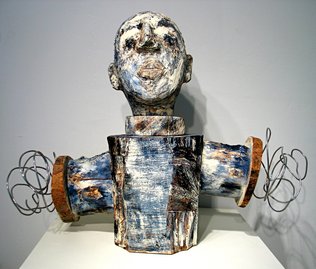Victoria Dalkey, Sacramento Bee
Northern California artist Carol Setterlund, who was born in Humboldt County and now lives near Healdsburg, has earned a solid reputation for her enigmatic wood sculptures of totemic figures.
On view at the Pamela Skinner/ Gwenna Howard Contemporary Art, a selection of her sculptures and paintings make for an elegant and emotive display.
Her figures take the form of large heads set atop columns of tree stumps with surfaces crudely carved, gouged and scratched so that they reveal many layers of pigmented wood. Sometimes built up with wood putty, the savage yet sensitive faces are anonymous yet emotionally compelling. Their anonymity gives them a universal quality, yet there is specificity in the emotions conveyed.
In a trio of figures at the center of the gallery, one discerns three distinct personalities. “Sordino” has the look of a philosopher; “Hermano,” as his name suggests, is a brotherly type with a faint resemblance to an elderly Fred Astaire; “Deja Vu” presents the wide-eyed expression of a childlike character.
Other works suggest associations with classical and biblical references. “Babel” is a tower of segments of stumps, some configured with patterning that suggests sedimentary layers with marbled surfaces. It speaks, as the title suggests, with many tongues, the head atop the totem deeply etched with care under a halo of tangled wire.
“Mending” is a raw presence with a large head. A long crack is mended with wood staples down one side of the face like a ladder of stitches. “Cut Off” is a large head placed low on the ground with a crown of stones on its bald pate. “Mysterium” is a tall figure with a large head and a necktie of wire. It stares back at you at eye level atop a barrel-shaped base studded with nails.
While there is a sameness to most of the sculptures, there is some variety in the tone and coloration of the figures. “Enigma” is delicate, almost pretty, suggesting a feminine presence.

“One Man Band” is a humorous guy, a little clownlike, with wide-stretched arms ending in spirals of aluminum suggesting cacophonous music. “Sea Legs” is a salty character with wooden legs and a decidedly male physique.
While Setterlund’s early work was drawn from nature and was reminiscent of the works of English sculptor Barbara Hepworth, since the late 1980s she has focused on the human figure as an existential emblem of pain and survival. Her rough surfaces speak of emotional wear and tear, yet the figures hold their heads high with hope.
Stemming from early 20th century traditions and demonstrating affinities with tribal sculptures and the works of Alberto Giacometti and Constantin Brancusi, the works also reflect a specifically Northern California aesthetic associated with Morris Graves and Jack Tworkov.
Setterlund’s sculptures are supported by an array of paintings that again draw on modernist impulses and Northern California aesthetics. Some are reminiscent of works by Paul Klee, Jean Arp and Jean Dubuffet but all are intensely felt and of a piece with her three- dimensional works.
As Bob Hanamura wrote of a recent show at the Sonoma Museum of Visual Art in Santa Rosa, “A sense of history prevails (in Setterlund’s work) like some archetype in a primeval forest. Standing in the middle, surrounded in the round … (the figures) bestow a calming effect, as if these beleaguered forms had endured and prevailed over time immemorial. Battered as they may be, a calm dignity reigns, as if the encounters over time had healed while the inner spirit remains unscathed.”
Well said.
As others have noted, the raw, weathered textures of her pieces are symbols of endurance and survival. As such, they nourish us with hope for surviving our own travails.
Victoria Dalkey
Sacramento Bee
April 2009